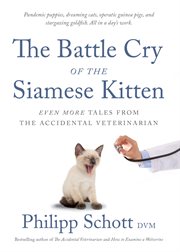Nonfiction
eBook
Details
PUBLISHED
Made available through hoopla
DESCRIPTION
1 online resource
ISBN/ISSN
LANGUAGE
NOTES
From Dr. Schott's 30 years in veterinary practice come over 60 heartwarming, funny, and adorable stories about angry pelicans, bug-eyed goldfish, and plenty of cats and dogs In the third book in this bestselling series, we meet the oddest creatures, from an escaped newt to a baby snow leopard, but the focus is on the dogs and cats that make up most of a pet vet's day and on the wacky and wonderful people who bring them in. Dr. Schott also pulls back the curtain on what it's really like to be a veterinarian. Do some vet students faint at the sight of blood? (Yes.) Is it easier for vets to bring their own pets in for procedures? (No.) Did the pandemic change veterinary practice? (Yes, and how.) You will also learn how to bathe a dog, why some rats love cats, why Dr. Schott is afraid of parrots, and a surprising way for a dog to accidentally get drunk. And, of course, you will meet Supercat, the Siamese kitten with the mightiest lungs. The Battle Cry of the Siamese Kitten is Dr. Philipp Schott's third collection of funny, touching, and informative true veterinary stories drawn from his over 30 years in practice. Philipp Schott grew up in Saskatoon, where he studied veterinary medicine. He is now chief of staff at a large pet hospital in Winnipeg, MB. He lives with three humans and four animals in a creaky old house on the river. The Battle Cry of the Siamese Kitten is his fifth book. Preface Here we are again. Or at least, here I am again. I suppose this could be your first time picking up one of my books. Either way, welcome or welcome back, and thank you. And if it is your first time, don't be afraid. You don't need to read the books, or even the tales within them, in order as they don't build on each other. Each tale is a discrete self-contained unit, like a snack, rather than an ingredient meant to be blended. Most other books are grand multi-course meals, whereas I like to think of my three veterinary books as collections of story snacks, or tapas if you prefer. You have 60 tiny plates in front of you (and about 120 more in the other books - think of them as adjacent tables, easily within reach if you stretch a bit). They are laid out left to right but pick them up as you please. Eat them all in one sitting, or one per day, or ten per weekend, or at entirely random and wanton intervals. When I began writing the first book, The Accidental Veterinarian, I briefly considered trying to weave the stories into a continuous narrative, like a traditional book. Many of the individual stories already existed as blog posts, so I would have to write some sort of filler to connect them. Filler sounds pejorative, doesn't it? I don't mean it that way. The filler might have been beautiful and engaging, but it would have been false. I'm blessed with a good memory, but not an unnaturally good one that allows me to conjure up the level of detail needed to turn all these stories into a smooth continuum. I did exactly that with The Willow Wren, the fictionalized memoir of my father growing up during the rise and fall of Hitler's Germany (yes, that was shameless plug for an unrelated book), and there the filler worked, but it didn't feel right for my veterinary stories. Moreover, I thought that there might be a place in the modern reader's library for collections of story snacks. I hope I am right. In the spirit of story snacking, I've done away with the sections in this volume. The Accidental Veterinarian and How to Examine a Wolverine were divided into four sections each, roughly grouping stories by type - sort of thematically in the first book and sort of by species in the second. But for a significant number of stories, these categorizations felt arbitrary. Here the snack metaphor breaks down. Until they start making sweet chips, salty fruit, or crunchy cheese, it's fairly easy to group snacks. Veterinary stories, not so much. So here you will hav
Mode of access: World Wide Web







